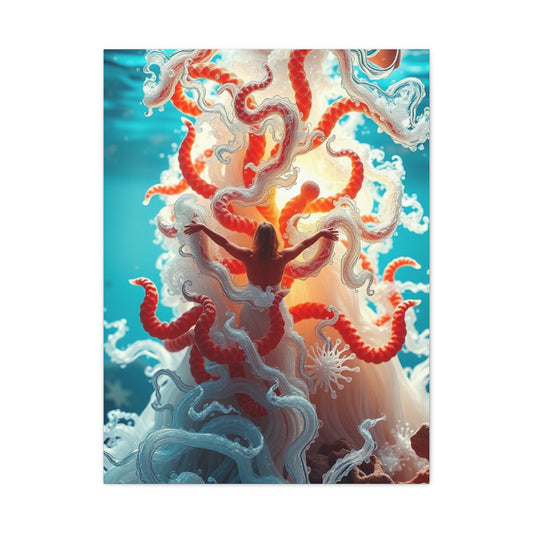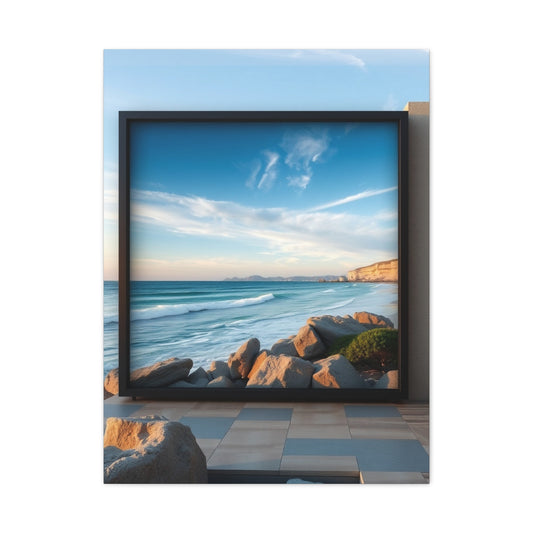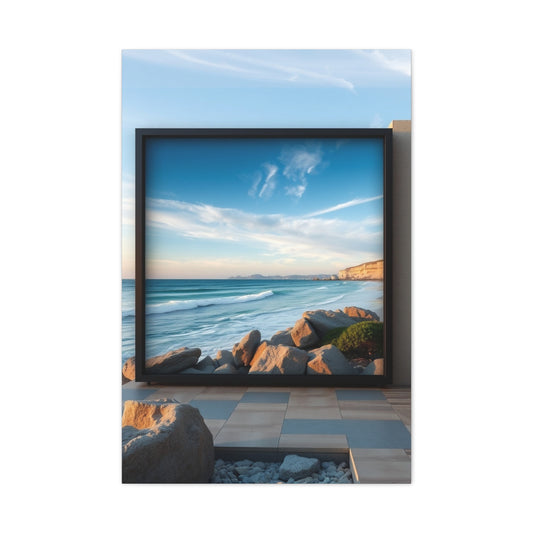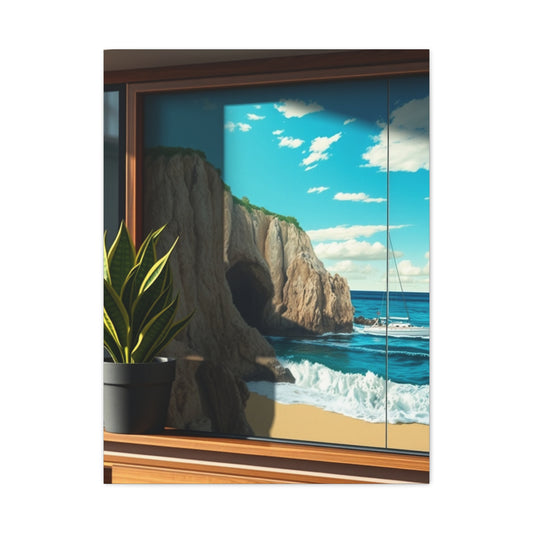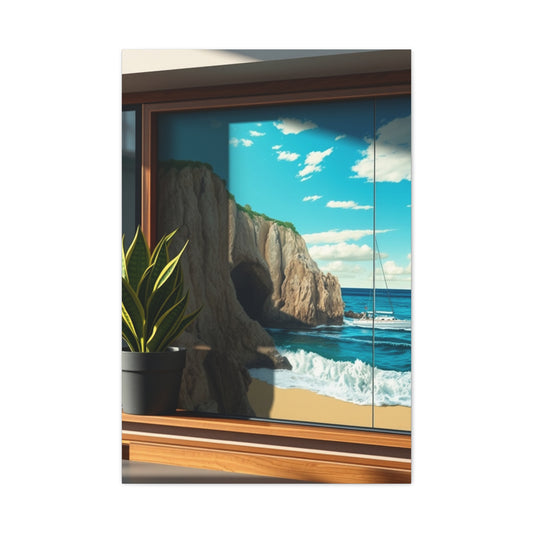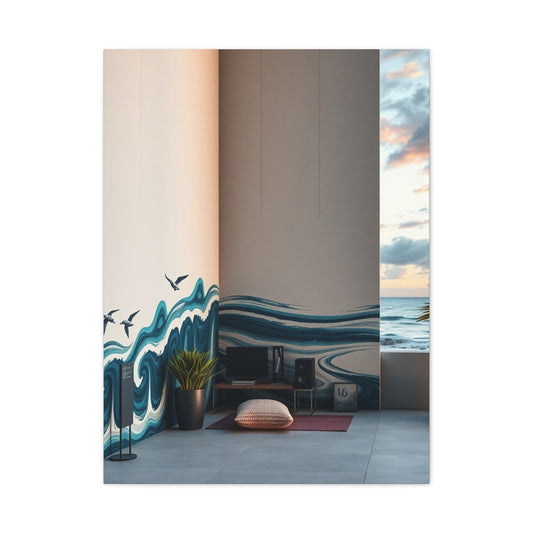Transforming your living space with oversized wall art is one of the most effective and visually impactful strategies in modern interior design. In 2025, designers and homeowners alike are embracing large-scale artwork to enhance aesthetics, establish ambiance, and express personal style. With evolving trends that emphasize bold statements, experimental layouts, and sustainability, oversized wall art has become more than décor—it's an essential element of architectural storytelling. This guide offers a deep dive into how to harness the power of large-format artwork to redefine the personality and presence of your home.
Embracing Oversized Art: A Modern Statement in Design
Oversized wall art is transforming the narrative of modern interior design, evolving beyond surface-level decoration into a tool for spatial storytelling. As living spaces become more curated and emotionally attuned, large-scale artwork is emerging as a preferred design language that resonates with both contemporary sensibilities and timeless elegance. In 2025, homeowners and interior designers alike are increasingly embracing the powerful impact of singular, expansive art installations to redefine visual dynamics within the home.
Unlike traditional collections of smaller frames, a single large piece of art consolidates visual energy and offers a more harmonious aesthetic. It functions not only as a focal point but also as a unifying force that ties together color palettes, furniture placement, and architectural lines. This scale-driven approach strips away the clutter, favoring simplicity with grandeur. Whether it’s a haunting monochromatic portrait, a vivid abstract, or a surreal landscape, oversized wall art introduces presence and purpose that transform any room into a gallery-like experience.
The conceptual strength of large-format artwork also lies in its ability to shape mood. Its sheer size allows for deeper immersion, making the viewer feel enveloped by the imagery. This intimacy is rarely achieved with smaller decor items. When thoughtfully chosen, oversized art becomes an emotional anchor for the space, enhancing the psychological atmosphere through both theme and tone. A vast seascape might instill tranquility in a bedroom, while a dynamic abstract may energize a living room with movement and rhythm.
|
Related Catagories: |
Moreover, oversized artwork is not limited to high ceilings or sprawling homes. In fact, it often works wonders in smaller rooms by exaggerating height or width, altering the perception of scale to make a space feel larger and more open. Vertical compositions can elongate walls, while horizontal pieces can stretch tight areas, giving rooms a sculptural fluidity that architectural features alone may lack.
Elevating Aesthetic Functionality in Modern Interiors
Oversized wall art has transcended traditional boundaries of form and function. It doesn’t simply fill a void—it actively redefines the room it inhabits. In open-concept living arrangements, where spatial divisions are often undefined, a large artwork helps delineate zones naturally. A dramatic piece above a dining table, for example, signals a distinct area for gathering and conversation, separating it from adjacent living or kitchen zones without using physical barriers.
This design strategy extends beyond visual compartmentalization. Large artworks also influence how people interact with the space. They slow down movement, encouraging pause and reflection. A grand canvas in a hallway transforms a transitional corridor into a contemplative moment. Likewise, a bold, expressive piece in a foyer offers immediate character, setting the tone for the entire home upon entry.
In rooms where architectural details may be minimal, such as blank walls or flat ceilings, oversized artwork injects structure and depth. It draws attention upward, outward, or inward—depending on placement and orientation—creating layers within flat environments. This strategic enhancement of architectural flow turns static environments into expressive, evolving atmospheres.
The visual impact of oversized art also fosters minimalism in other elements of the room. When the eye is drawn to a single commanding piece, there is less need for excess decor. Furniture can be kept streamlined, textiles neutral, and lighting subtle, allowing the artwork to carry the narrative. This synergy between form and restraint cultivates balance and sophistication that resonates across diverse design styles, from urban modern to rustic chic.
Harmonizing Color, Texture, and Scale
Incorporating oversized artwork into interior design requires a refined understanding of proportion, hue, and texture. Size should always be intentional. Artwork that is too small will appear dwarfed by surrounding furniture or architectural elements, while a piece that’s too large can feel intrusive or destabilizing. The most visually pleasing results often come from following the two-thirds rule—selecting artwork that spans roughly two-thirds the width of the furniture below it.
Color is a powerful vehicle for emotional expression in large-scale pieces. Cool palettes—like icy blues, dusty greens, or lavender grays—evoke serenity and are ideal for spaces of rest and reflection. Warmer tones—burnt sienna, ochre, or persimmon—stimulate energy and conversation, making them suitable for communal areas. Neutral tones, including bone, slate, and mushroom, work across all room types, providing grounding without dominance.
Texture deepens the visual experience, especially at this scale. Pieces with layered paint, natural fibers, metallic leaf, or embedded materials such as resin or wood grain respond to light in dynamic ways. These surfaces create changing patterns throughout the day, catching sun or lamplight in unexpected places, which can animate the artwork with subtlety and motion. Mixed-media pieces often provide this dimension, offering a richer tactile interaction and sensory intrigue.
Material selection also plays a practical role. For humid environments, such as bathrooms or kitchens, acrylic glass-mounted artwork or aluminum-backed prints are preferred for their durability. In more controlled climates, traditional stretched canvas or wooden panels work well. Wherever it's displayed, the physical presence of the piece should match its thematic weight—light, airy pieces for relaxed settings and bolder, textured works for dramatic or expressive rooms.
Integrating Art with Lighting, Placement, and Sustainability
The final impact of oversized wall art depends significantly on how it's placed and illuminated. Correct placement ensures the artwork becomes a harmonious part of the room’s architecture. Ideally, the center of the piece should sit around 57 inches from the floor, aligning with average eye level. This rule of thumb applies whether the viewer is standing or seated and creates visual comfort in nearly every setting.
Allowing breathing room around the art is also essential. Leave several inches between the frame and architectural features like crown moldings or ceiling lines. In narrow spaces, such as hallways, balance the verticality of the artwork with lighting that spreads laterally, preventing visual congestion.
Lighting elevates the effect of large-scale art, turning it from static object to animated centerpiece. Adjustable track lighting, smart LED fixtures, or subtle uplighting can be used to accentuate texture and depth. Positioning lights at a 30-degree angle typically reduces glare while enhancing pigment fidelity. In settings without hardwired lighting, floor lamps with directional heads provide an effective alternative. Smart bulbs allow programmable dimming that protects the artwork from UV exposure and adapts to the room’s shifting moods.
As sustainability becomes an integral part of home design, it’s increasingly important to select wall art produced with ethical materials and methods. Seek pieces printed with water-based inks, mounted on FSC-certified wood, or framed with reclaimed materials. These options not only reduce environmental impact but also bring organic warmth and authenticity to the artwork.
Even for budget-conscious decorators, oversized art can be accessible. High-resolution digital artwork can be commissioned from independent artists and printed through reliable vendors on rolled canvas or sustainable substrates. Splitting a panoramic piece into diptychs or triptychs also reduces printing costs while preserving the grandeur of scale. With the right approach, anyone can bring dramatic, gallery-inspired style into their space without compromising quality or conscience.
Innovative Shapes and Configurations in Oversized Wall Art
In the evolving language of interior design, the shape of wall art has taken on a renewed significance. As spaces become more personalized and emotionally expressive, designers are discarding the predictability of conventional rectangular formats in favor of unique and sculptural configurations. Oversized wall art is no longer confined to the traditional flat rectangle—it now bends, curves, clusters, and expands in myriad ways, forming immersive, architectural statements.
Circular canvases offer a compelling departure from angularity, softening rigid interiors with their celestial and organic form. These spherical shapes suggest continuity, completeness, and harmony. They work particularly well in minimalist or industrial spaces, where linear lines dominate. The circle, devoid of edges, creates a meditative focal point that gently contrasts hard surfaces and brings visual calmness.
Diptychs and triptychs allow for narrative expansion. By splitting a single composition across two or three aligned panels, they introduce rhythm, pacing, and spatial engagement. The placement of these panels—either equally spaced or staggered—draws the eye vertically or laterally, reinforcing room dimensions and adding height or breadth. These multi-panel works are ideal for large empty walls where a singular canvas might appear static. Their modularity also makes them versatile in dynamic or evolving interiors.
Hexagonal clusters inject a sense of organized playfulness. These honeycomb-inspired groupings create kinetic patterns that balance precision with whimsy. Often used in creative zones like studios or children's rooms, hexagonal arrangements can be symmetrical or asymmetrical, offering both harmony and spontaneity. Their geometric nature introduces architectural interest and depth, while their modularity allows for custom expansion across irregular walls.
Curved panoramic pieces introduce an advanced level of spatial storytelling. These works are designed to wrap gently around corners or bow outward from the wall, creating a sensation of envelopment. In expansive rooms with wide, uninterrupted surfaces, curved artworks become immersive backdrops that break visual rigidity and establish movement. They are particularly effective in hallways, open-plan lounges, or transitional zones where spatial flow is a design priority.
The emergence of these shapes reflects a broader shift in design priorities—toward experiential and kinetic environments. Shapes now serve more than an aesthetic function; they shape perception, guide sightlines, and influence how individuals emotionally respond to a room. Choosing the right configuration depends on more than taste—it involves a considered understanding of how art interacts with architectural elements, furniture, lighting, and human movement.
The Power of Placement: Sculpting Perception with Shape
Strategic placement of uniquely shaped oversized wall art can transform a flat room into a layered and dynamic environment. Unlike standard rectangles, which are often predictably centered, unconventional shapes give you the freedom to play with asymmetry, movement, and framing.
Circular pieces, for example, are not bound by vertical or horizontal alignment. They can be centered above round tables, placed off-center to offset symmetry, or hung as a trio to mimic phases of the moon. Their fluid nature allows them to integrate into any aesthetic—from Scandinavian serenity to contemporary maximalism.
Multi-panel works like diptychs or triptychs offer creative positioning opportunities. The vertical split of a diptych can visually stretch a low ceiling, while a horizontal triptych can open up a narrow corridor or emphasize the linearity of a dining space. Varying the spacing between panels adds further dimension, turning the wall into a narrative sequence that unfolds visually as one moves through the room.
Hexagonal pieces can be arranged to suit nearly any wall shape. In irregular or diagonally cut walls, hexagons act like tessellated tiles, fitting together in endless formations. When used with bold colors or layered materials, they create kinetic installations that feel almost alive, shifting perception with changing light and viewpoint.
Curved art, though less common, offers unparalleled immersion. These works demand thoughtful placement, often best suited to corner walls, alcoves, or wide horizontal planes where they can truly embrace the viewer. In commercial settings such as galleries or boutique hospitality interiors, curved panoramic art offers a high-impact, sculptural focal point.
In every case, the interaction between shape and setting must be intuitive. The best oversized artworks do not dominate but collaborate with the space around them, emphasizing architectural beauty while providing emotional resonance.
Proportions That Command Attention and Define Harmony
While the shape of oversized art adds intrigue, its size and proportion determine its impact. An artwork must speak to its environment, echoing its scale and mood without overwhelming or underwhelming the space. The most successful compositions strike a careful balance between prominence and poise.
The widely accepted two-thirds rule offers a helpful framework: the width of the artwork should occupy about two-thirds the width of the furniture it is paired with. This guideline ensures that the piece feels anchored and integral to the room’s composition rather than floating awkwardly. When placed above a sofa, console, or bed, this proportional relationship brings visual coherence and flow.
In large rooms, especially open-plan living areas or lofts, scale becomes crucial. A piece measuring 72 inches or more in width may be necessary to counteract spatial drift, where furniture and decor feel disconnected without a dominant visual anchor. Oversized art in these settings helps create focal points, define functional zones, and encourage emotional cohesion across open spaces.
In compact environments, verticality can compensate for a lack of floor area. A 48-inch tall, narrow piece draws the eye upward, giving the illusion of higher ceilings and more volume. These works are excellent for entryways, staircases, or small apartments where wall space is limited but design aspirations are high.
Testing dimensions before installation is highly recommended. Using painter’s tape to outline the proposed artwork on the wall offers a tangible preview of the scale and placement. This practice helps prevent costly errors and ensures the piece will integrate seamlessly with its surroundings.
Ultimately, oversized wall art is about making confident design choices. It is an opportunity to redefine the hierarchy of visual elements in a space, giving precedence to form, color, and narrative. Proper scale ensures that the art remains a statement without becoming a shout—powerful, elegant, and contextually refined.
Balancing Visual Weight Through Color, Material, and Context
In oversized artworks, proportion must be harmonized with visual weight—an abstract yet critical factor influenced by color, material, and spatial context. A large piece in muted tones may feel lighter than a smaller work saturated with bold color. Similarly, a translucent acrylic may carry less visual heft than a heavily textured oil painting, even if they share dimensions.
Color choices can either amplify or balance the spatial effects of size. In smaller rooms, choosing cooler tones—such as mist, sage, or sky blue—can expand the room visually and lend a sense of tranquility. In contrast, warm or saturated colors—amber, crimson, indigo—can energize social spaces, creating vibrancy and visual gravity.
Material finish also impacts perception. Matte surfaces absorb light and reduce glare, often blending into softer surroundings. High-gloss finishes, metallic leafing, or glass-mounted prints reflect ambient light, creating brighter, more energetic statements. These finishes can either harmonize or contrast with existing decor, depending on the desired effect.
The context in which oversized art exists should never be an afterthought. For example, a curved panoramic piece placed above a sofa may need wall-mounted lighting to highlight its contours. A vertical triptych beside a narrow window could benefit from natural light, reinforcing its upward thrust. These contextual choices frame the artwork, guiding how it is seen and experienced throughout the day.
Incorporating oversized wall art isn’t simply about filling space—it’s about orchestrating a dialogue between color, form, material, and the room itself. The right shape and scale, when thoughtfully aligned with the environment, elevate design into a multisensory experience that engages sight, emotion, and memory.
Bedroom: Creating a Personal Sanctuary with Oversized Art
The bedroom is more than a place to sleep—it is a refuge, a personal retreat where serenity, warmth, and emotional comfort take precedence. In this context, oversized wall art becomes more than decoration; it acts as a sensory experience, weaving atmosphere and intention into the fabric of the room. Unlike smaller pieces that may dissipate in a space, large-format artwork creates a soothing focal point that defines the mood and encourages emotional equilibrium.
Incorporating artwork with soft, diluted gradients can dramatically affect the tone of a bedroom. Abstract works in shades such as smoky plum, dusk lavender, or subtle oyster grey bring tranquility without becoming static. These nuanced hues communicate peace while gently engaging the eye. When framed with brushed metallic or slim wooden edges, they integrate seamlessly with modern or transitional bedroom decor.
Botanical imagery continues to be a favored subject in restful spaces. Macro florals, leafy silhouettes, and textured plant-based motifs offer more than aesthetic appeal—they evoke a sense of life and natural rhythm. When used in large scale, they can simulate the presence of a window into nature, especially effective in urban apartments or windowless nooks. A wall-spanning print of eucalyptus branches or magnolia blooms introduces organic texture, supporting biophilic design principles that align with mental wellness and restorative living.
Positioning oversized art in a bedroom must be deliberate. The wall above the headboard remains the most impactful placement. Hanging the artwork roughly six inches above the headboard ensures visual continuity between bed and wall, forming a vignette that feels anchored yet weightless. This proportional harmony prevents dissonance, offering balance and integration within the room’s composition.
Additional design cohesion can be achieved by selecting artwork that resonates with other elements in the bedroom—bedding, curtains, accent rugs, or lighting. A faint echo of color or texture between these components creates a subtle rhythm that guides the eye naturally from one point to another, enhancing the overall serenity of the space.
Lighting and Materiality in Bedroom Art Displays
Lighting plays a silent but significant role in enhancing the ambiance of bedroom art. Unlike brighter living areas, bedrooms benefit from diffused, low-intensity lighting that respects the room’s tranquil intention. Directional sconces flanking a large artwork can highlight subtle textures and color transitions while casting a gentle glow that doubles as ambient lighting.
Picture lights installed just above the frame can further elevate the piece, emphasizing brushstrokes or material layers. This creates depth and shadow interplay, especially in textured artworks or mixed-media compositions. Smart bulbs with dimmable functionality are ideal, as they allow control over brightness and temperature, shifting the mood from early morning to nighttime calm.
Material selection for oversized bedroom art should reflect softness and sophistication. While canvas remains a reliable and accessible choice, other materials like linen-mounted panels, natural fiber tapestries, or fine art paper framed under matte acrylic can introduce layers of warmth and tactile interest. These surfaces respond differently to light and air, providing subtle dynamism throughout the day.
Art in bedrooms should never dominate but instead become an extension of the room’s emotional language. The goal is not theatrical spectacle, but an immersive ambiance that soothes and nurtures. With the right piece, placed with care, even the quietest room can feel infused with presence and purpose.
Living Room: Energizing the Social Epicenter with Bold Art
The living room often serves as the most expressive and multifaceted zone within the home—a place where hospitality, personality, and storytelling converge. Oversized wall art in this setting should reflect these values, serving not only as a design element but as an articulation of the homeowner’s voice. In 2025, bold, large-format artwork remains at the forefront of living room aesthetics, turning walls into visual declarations of identity and style.
One of the most impactful choices for living rooms is black-and-white photography rendered in high resolution and printed on archival-grade materials. Urban street scenes, candid portraits, and abstract architectural forms lend timeless gravitas to contemporary interiors. The absence of color focuses attention on texture, contrast, and composition, offering elegance that is both restrained and powerful.
|
Related Catagories: |
For those seeking energy and vibrancy, color-block expressionism is a dynamic alternative. These works rely on large, confident fields of color—think ultramarine, saffron, deep teal, or persimmon orange—to animate a room. These hues can awaken neutral furnishings and anchor an otherwise minimalistic palette. Abstract expressionist canvases in large sizes often radiate kinetic energy, making them ideal for active, social environments.
The scale of the art should correspond to the visual weight of the furniture. Placing a 72-inch-wide piece above a three-seater sofa, for example, ensures balance and proportion. The artwork becomes an integral part of the arrangement, not an accessory but an architectural element in its own right.
Integrating oversized art also allows for more strategic and minimalist accessorizing. When a wall is dominated by a strong piece of art, surrounding decor can be kept restrained—clean-lined coffee tables, organic textures in throws or rugs, and subtle lighting. This restraint lets the art shine, and paradoxically, makes the entire space feel more curated and composed.
Enhancing Living Room Art with Lighting and Spatial Rhythm
Lighting in the living room is more flexible and layered, making it easier to highlight large-scale art dramatically. Adjustable track lighting, ceiling-mounted spotlights, or even sculptural floor lamps can be used to create directional focus on wall art. Positioning light at a 30-degree angle typically minimizes glare and enriches color saturation.
Minimalist sconces placed symmetrically beside the artwork not only add visual framing but also emphasize vertical lines, drawing the eye upward and expanding the perceived height of the room. Picture lights can add a gallery-like effect, particularly effective in evening settings where ambiance matters most.
Material choice in living room artwork should align with the room's character. For industrial or modern settings, aluminum panels or acrylic glass offer a reflective, polished aesthetic. For eclectic or organic interiors, textured canvas, rough linen, or reclaimed wood backing introduces warmth and tactile richness. Mixed-media works incorporating resin or natural pigments further elevate the sensory appeal, offering dimension that shifts with changing daylight.
The art should harmonize with the energy of the living space. In homes with high ceilings, oversized vertical compositions can create grandeur, while wide horizontal works expand lower-ceilinged rooms and make them feel more generous. The integration of the piece into the spatial rhythm—its distance from furniture, its alignment with sightlines, and its interaction with architecture—determines how immersive it truly becomes.
Oversized wall art in the living room is a chance to go beyond trends and create something deeply personal and permanent. Whether it’s calm minimalism or expressive maximalism, the right piece can turn a gathering space into a resonant environment filled with vitality and visual identity.
Kitchens and Dining Areas: Merging Function with Flair
In contemporary interior design, kitchens and dining spaces are no longer merely functional zones—they have evolved into expressive, sensory-rich environments where aesthetics are just as important as utility. The strategic use of oversized wall art in these areas plays a crucial role in transforming them from utilitarian spaces into visually compelling extensions of the home’s overall design narrative. However, selecting art for kitchens and dining rooms demands a careful balance between form, durability, and maintenance.
These spaces often contend with variables like steam, fluctuating temperatures, and splashes of water or oil, making material choice paramount. Acrylic-glass-mounted prints emerge as an ideal solution. Their high-gloss, non-porous surface resists humidity and is effortless to clean, making them particularly suitable for the high-activity zone of the kitchen. Unlike traditional canvas, which can absorb moisture and degrade over time, acrylic glass maintains its integrity and luster in challenging environments.
In terms of subject matter, vibrant still lifes reign supreme in culinary settings. Modern reinterpretations of classic compositions—think abstract citrus slices, richly saturated pomegranates, or hyper-realistic clusters of herbs—add flavor to the visual landscape. These works do more than echo the function of the space; they evoke warmth, appetite, and conviviality. Their chromatic richness and organic shapes harmonize with food-related elements, creating an immersive atmosphere that stimulates the senses even before a meal is served.
In dining rooms, panoramic landscapes hold special appeal. A horizontal piece depicting a rolling vineyard, distant mountain range, or coastal vista can dramatically alter the perceived spatial boundaries of a room. These artworks introduce a sense of depth and movement, transporting guests beyond the immediate confines of the walls and into imagined, expansive environments. This visual escapism enhances the dining experience by infusing it with a narrative of travel, tranquility, or romanticism.
The placement of oversized art in these areas also affects flow and ambiance. In kitchens, pieces are best positioned away from direct cooking zones to preserve longevity, while still occupying a prominent visual axis—perhaps above a breakfast nook or on a blank wall adjacent to cabinetry. In dining rooms, the wall opposite the table or behind a sideboard provides the ideal canvas for statement art. Ensuring the artwork aligns with the eye level of seated guests enhances its engagement and makes it a conversational focal point.
Enhancing Culinary Spaces Through Scale, Tone, and Lighting
Selecting the right scale of art for kitchens and dining areas is vital to achieving spatial harmony. In compact kitchens, a vertically oriented piece can elongate walls and create a sense of openness. For larger dining rooms, artworks stretching over 60 inches in width can anchor the space and provide a counterbalance to heavy furniture or expansive tables. The art should neither dominate the environment nor feel like an afterthought—it should embody presence with purpose.
Color palette plays an equally significant role. Warm, earthy tones—such as terracotta, olive green, ochre, and burnt orange—echo the natural ingredients used in cooking and lend a grounded, rustic charm. Cooler hues—slate blue, seafoam, or silvery gray—can offer contrast in all-white or stainless steel-heavy kitchens, bringing a layer of sophistication without overwhelming the space. The selected tones should complement cabinetry, countertops, and lighting fixtures to maintain a cohesive aesthetic.
Lighting, often overlooked in art curation, is essential for maximizing the visual impact of wall pieces in culinary spaces. Kitchens typically feature task lighting, but accent lights like under-cabinet LEDs or pendant lamps can be directed to highlight the artwork. In dining rooms, adjustable ceiling fixtures or picture lights positioned above or beside the art piece can create a dramatic yet intimate setting. Soft, warm light enriches colors and textures, adding depth and dimension to even the flattest mediums.
Sound absorption is another unexpected benefit of oversized art in dining areas. Pieces mounted on fabric-backed panels or thick wooden frames can reduce ambient noise, softening clinks and chatter to make the room feel more serene. This acoustic improvement, though subtle, contributes to a more comfortable dining experience and reinforces the role of art as both functional and ornamental.
Exploring Materials Beyond Traditional Canvas
The evolution of wall art materials has expanded design possibilities far beyond the limitations of traditional stretched canvas. In 2025, interior designers and homeowners are exploring diverse substrates that not only offer aesthetic variety but also respond to environmental factors and tactile engagement. This material revolution brings texture, sheen, and dimension into rooms, transforming flat art into sensory sculpture.
Brushed aluminum panels introduce a clean, industrial finish that’s both modern and versatile. Their semi-reflective quality subtly amplifies ambient light, enriching the vibrancy of colors and sharpening contrast. Especially suited for urban lofts and modern high-rises, aluminum-mounted art complements exposed materials like concrete, glass, and steel. These panels are also highly durable and moisture-resistant, making them suitable for kitchens and transitional areas.
Acrylic glass remains one of the most visually arresting substrates. Its hyper-polished surface creates a luxurious sheen that enhances depth and clarity, particularly for photographic or digital artworks. When mounted with standoff bolts or frameless edges, acrylic pieces take on a floating effect that adds a futuristic elegance to interiors. In high-traffic or humid spaces, their easy-clean surface is both practical and visually striking.
For interiors seeking an organic or vintage appeal, rustic wooden planks printed with UV-cured ink provide a tactile antidote to smooth surfaces. The grain of the wood adds a unique pattern to each piece, while the ink’s permanence ensures longevity. This option works beautifully in farmhouse kitchens, bohemian dining rooms, and any space where texture and authenticity are prized.
Mixed-media artworks are also gaining momentum, particularly those that incorporate resin pours, metallic foil, sand textures, or fabric layering. These pieces evolve as the light changes throughout the day, offering new experiences from different angles. Their dimensionality adds visual richness, turning a wall into an ever-changing landscape of shadows and highlights.
Harmonizing Style, Sustainability, and Storytelling
Beyond material and form, the integration of oversized wall art into kitchens and dining areas is also an opportunity to support sustainability and ethical design. Eco-conscious consumers are increasingly seeking art that aligns with their values, choosing pieces made with responsibly sourced materials and low-impact production processes.
Look for artwork printed on FSC-certified wood or recycled metal panels. Artists using water-based inks and non-toxic adhesives reduce the carbon footprint of their creations, making them healthier choices for indoor environments. Some creators also repurpose old furniture, barnwood, or reclaimed architectural elements into one-of-a-kind backdrops for their art, imbuing each piece with history and character.
Commissioning art from local artisans or emerging creators ensures a more personalized piece while supporting community-based economies. Many artists now offer custom digital files that can be printed on sustainable substrates, combining affordability with environmental responsibility. This approach allows for greater flexibility in scale and material choice while aligning with the growing trend of bespoke home design.
Each piece of oversized wall art tells a story, and in kitchens and dining rooms, that story should mirror the spirit of gathering, nourishment, and creativity. Whether it’s a sun-drenched vineyard stretching across a dining wall or an abstract depiction of flame and spice in a kitchen, the artwork becomes part of the sensory journey shared in those spaces.
By blending aesthetic ambition with material intelligence and ethical awareness, oversized wall art becomes more than a backdrop—it becomes an integral element in crafting spaces that are not only beautiful but meaningful and enduring.
Color Palettes That Shape Mood and Emotion
Color is one of the most influential design elements, directly impacting how a space feels and functions. The palette of your oversized wall art should align with the room’s purpose and personality.
Cool hues—shades of seafoam, periwinkle, and celadon—calm the mind and are ideal for bedrooms, reading nooks, and meditation spaces. These colors harmonize with soft textures and natural materials.
Warm, vibrant tones like vermillion, mustard, and flame orange ignite energy. These palettes are excellent in kitchens, living rooms, and entryways, where stimulation and sociability are key.
Neutral tones—ranging from bone and sand to fog gray and slate—create understated elegance. They allow other design elements, like textiles and furniture, to take center stage, while subtly tying the space together.
When selecting a piece, consider echoing one or two accent colors from existing decor, such as area rugs or curtain fabrics. This creates cohesion without appearing overly coordinated.
Hanging Guidelines for Cohesion and Impact
Art placement is just as important as selection. Misplaced art can disrupt flow and visual harmony, while well-positioned pieces bring balance and completeness to a room.
The center of your oversized art should sit approximately 57 inches from the floor. This guideline places the focal point at average eye level, offering comfortable viewing whether seated or standing.
Allow a minimum of three inches between the top edge of the artwork and any crown molding or ceiling element. This breathing space prevents a cramped or cluttered appearance.
When hanging multiple artworks as part of a gallery formation, maintain even spacing—typically four inches between frames. Equal distance fosters symmetry and a curated, intentional aesthetic.
Lighting Techniques to Accentuate Art
Without proper lighting, even the most stunning art can fade into the background. Effective lighting brings out detail, color saturation, and texture, transforming passive pieces into interactive features.
Track lighting with adjustable heads allows directional control, ideal for rooms where light sources need to be flexible. A 30-degree angle prevents glare and distributes light evenly across the artwork.
Picture lights affixed above the frame provide focused illumination and a museum-quality ambiance. These fixtures draw attention while adding sophistication.
Floor lamps with tilting heads are excellent for apartments or rentals where installing hardwired lighting isn't an option. Pointed upward, they reflect off the ceiling and wash the artwork in gentle, ambient light.
Smart lighting systems, including dimmable bulbs and timed schedules, help protect pigments from UV exposure while allowing you to customize the display atmosphere.
Eco-Conscious Art Choices for a Sustainable Future
Sustainability is no longer a trend—it’s a design imperative. Oversized wall art can be both ethically produced and environmentally friendly without compromising beauty.
Choose artwork stretched on FSC-certified wooden bars to ensure timber was sourced from responsibly managed forests. This supports biodiversity and reduces deforestation.
Opt for prints made with water-based inks, which emit fewer toxins and are safer for indoor air quality. These inks are especially suitable for homes with children or pets.
Frames made from reclaimed wood reduce waste and add depth of character. Each frame tells its own story, with natural imperfections and patina that enhance visual interest.
NFT-linked physical prints are emerging as a solution for digital artists. They verify authenticity, support direct artist compensation, and reduce waste by eliminating mass production.
Achieving Maximum Visual Impact on a Budget
Creating an impressive interior doesn’t have to involve extravagant spending. With creativity and planning, anyone can incorporate oversized wall art affordably.
Purchase high-resolution digital files from independent artists. Print them on rolled canvas via a trusted lab and stretch the material yourself using online tutorials and framing kits.
Transform a single panoramic photograph into a budget-friendly triptych. By dividing the image into three vertical panels, you mimic the presence of a single large work while saving significantly on printing and shipping costs.
Explore second-hand markets for large frames or gently used art. With a bit of restoration or reframing, these pieces can gain new life and perfectly match your design intent.
Preserving and Maintaining Oversized Art
To ensure your artwork retains its vibrancy and integrity over time, consistent maintenance is key. Dust regularly using a dry microfiber cloth, taking care to avoid abrasive materials that could scratch or degrade the surface.
Do not use chemical cleaners on any artwork. For tough spots, lightly dampen a cloth with water and gently wipe, but test an inconspicuous area first to avoid damage.
Avoid prolonged exposure to direct sunlight. Even UV-protected inks can fade over time. Use protective coatings or position the art in shaded areas to maintain color longevity.
In humid climates, periodically check and tighten stretcher keys to prevent sagging. Rotate artworks seasonally to equalize exposure and refresh your interior with minimal effort.













